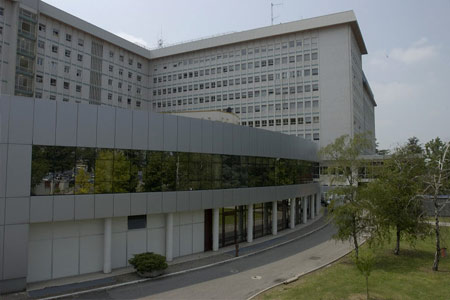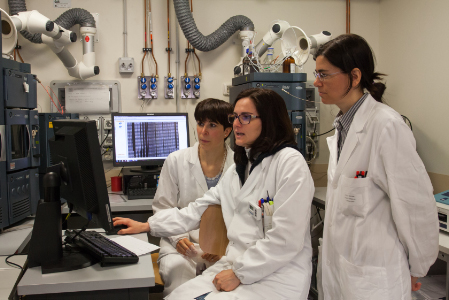- Autori:
-
Gringeri, Enrico; Villano, Gianmarco; Brocco, Silvia; Polacco, Marina; Calabrese, Fiorella; Sacerdoti, David; Cillo, Umberto; Pontisso, Patrizia
- Titolo:
-
SerpinB3 as hepatic marker of post-resective shear stress
- Anno:
-
2023
- Tipologia prodotto:
-
Articolo in Rivista
- Tipologia ANVUR:
- Articolo su rivista
- Lingua:
-
Inglese
- Formato:
-
A Stampa
- Referee:
-
Sì
- Nome rivista:
- UPDATES IN SURGERY
- ISSN Rivista:
- 2038-131X
- N° Volume:
-
75
- Numero o Fascicolo:
-
6
- Intervallo pagine:
-
1541-1548
- Parole chiave:
-
Hepatic marker; Hepatic resection; Post-resective shear stress; SerpinB3; Splenectomy
- Breve descrizione dei contenuti:
- Post-resective liver failure is a frequent complication of liver surgery and it is due to portal hyperperfusion of the remnant liver and to arterial vasoconstriction, as buffer response of the hepatic artery. In this context, splenectomy allows a reduction of portal flow and increases the survival chance in preclinical models. SerpinB3 is over-expressed in the liver in oxidative stress conditions, as a mechanism of cell defense to provide survival by apoptosis inhibition and cell proliferation. In this study, the expression of SerpinB3 was assessed as predictor of liver damage in in vivo models of major hepatic resection with or without splenectomy. Wistar male rats were divided into 4 groups: group A received 30% hepatic resection, group B > 60% resection, group C > 60% resection with splenectomy and group D sham-operated. Before and after surgery liver function tests, echo Doppler ultrasound and gene expression were assessed. Transaminase values and ammonium were significantly higher in groups that underwent major hepatic resection. Echo Doppler ultrasound showed the highest portal flow and resistance of the hepatic artery in the group with > 60% hepatectomy without splenectomy, while the association of splenectomy determined no increase in portal flow and hepatic artery resistance. Only the group of rats without splenectomy showed higher shear-stress conditions, reflected by higher levels of HO-1, Nox1 and of Serpinb3, the latter associated with an increase of IL-6. In conclusion, splenectomy controls inflammation and oxidative damage, preventing the expression of Serpinb3. Therefore, SerpinB3 can be considered as a marker of post-resective shear stress.
- Note:
- Post-resective liver failure is a frequent complication of liver surgery and it is due to portal hyperperfusion of the remnant liver and to arterial vasoconstriction, as buffer response of the hepatic artery. In this context, splenectomy allows a reduction of portal flow and increases the survival chance in preclinical models. SerpinB3 is over-expressed in the liver in oxidative stress conditions, as a mechanism of cell defense to provide survival by apoptosis inhibition and cell proliferation. In this study, the expression of SerpinB3 was assessed as predictor of liver damage in in vivo models of major hepatic resection with or without splenectomy. Wistar male rats were divided into 4 groups: group A received 30% hepatic resection, group B > 60% resection, group C > 60% resection with splenectomy and group D sham-operated. Before and after surgery liver function tests, echo Doppler ultrasound and gene expression were assessed. Transaminase values and ammonium were significantly higher in groups that underwent major hepatic resection. Echo Doppler ultrasound showed the highest portal flow and resistance of the hepatic artery in the group with > 60% hepatectomy without splenectomy, while the association of splenectomy determined no increase in portal flow and hepatic artery resistance. Only the group of rats without splenectomy showed higher shear-stress conditions, reflected by higher levels of HO-1, Nox1 and of Serpinb3, the latter associated with an increase of IL-6. In conclusion, splenectomy controls inflammation and oxidative damage, preventing the expression of Serpinb3. Therefore, SerpinB3 can be considered as a marker of post-resective shear stress.
- Id prodotto:
-
137360
- Handle IRIS:
-
11562/1117877
- ultima modifica:
-
11 maggio 2024
- Citazione bibliografica:
-
Gringeri, Enrico; Villano, Gianmarco; Brocco, Silvia; Polacco, Marina; Calabrese, Fiorella; Sacerdoti, David; Cillo, Umberto; Pontisso, Patrizia,
SerpinB3 as hepatic marker of post-resective shear stress
«UPDATES IN SURGERY»
, vol.
75
, n.
6
,
2023
,
pp. 1541-1548
Consulta la scheda completa presente nel
repository istituzionale della Ricerca di Ateneo 








